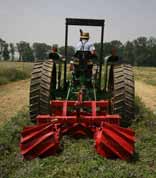30
Jan
Technical Bulletin Supports Conversion to Organic No-Till Organic
(Beyond Pesticides, January 30, 2012) The Rodale Institute has published a new technical bulletin containing information and resources to assist farmers in transitioning to diversified organic no-till cropping systems. No-till practices are highly effective for preventing soil erosion and can also decrease labor requirements and fuel use, but they typically depend on heavy pesticide applications to manage weeds in lieu of physical cultivation. This increased dependence on herbicides is unsustainable, contributing to herbicide resistance in certain weeds and increased leaching of pesticides into groundwater due to higher infiltration rates. The technical bulletin outlines the practices that organic farmers can use to capture the benefits of no-till and for conventional farmers to decrease or eliminate the need for herbicides. 
The technical bulletin contains guidance on using the specialized equipment that enables farmers to move beyond either routine tillage or pesticide applications. The key piece of equipment is a roller-crimper that knocks down the residues from annual crops and crimps them at a standard interval to create a thick vegetative mat into which the next crop is directly planted. The roller-crimper can knock down residues from a cereal crop, such as wheat and oats, or leguminous cover crops including red clover and hairy vetch. Farmers have a wide variety of options for what they plant next, from commodity crops. including corn and soybeans, to high value vegetables. The knocked-down vegetative mat remains more or less intact and in place, thereby reducing decomposition rates and increasing the time the mulch stays on the soil surface and works to suppress weeds. While roller-crimpers are not currently in wide use, the technology is relatively simple and purchasing or custom- building an appropriate model is within the standard equipment budget of most commercial farmers.
In addition to the technical details including equipment choices and cover crop and crop rotation recommendations, the bulletin contains economic and energy budgets that highlight the potential benefits of organic no-till systems. For example, total expenses in an organic no-till organic system are more than 20% lower compared to a tilled organic system due to significantly lower labor, fuel, and equipment costs. Research cited in the bulletin determined that production in a no-till organic system requires close to 30% fewer energy inputs than tilled organic corn production. The biggest energy savings result from the reduced number of field operations that farmers must undertake. In a tilled organic system up to 10 field passes may be required from cover crop termination to harvesting of the main crop (plowing, disking, packing, planting, and several cultivations for weed control), whereas the no-till roller/crimper system can take as few as two passes (rolling and planting and harvesting). Ongoing research at the U.S. Department of Agriculture’s (USDA) Sustainable Agricultural Systems Lab (SASL) finds that organic grain production reduces greenhouse gas emissions relative to chemical-intensive no-till and chisel-plow production systems.
The no-till cropping systems technical bulletin was partially funded through a grant from the USDA’s Northeast Sustainable Agriculture Research and Education (SARE) Program. Authorized under the 1985 Farm Bill, SARE operates nationally to advance the whole of American agriculture through innovations that improve profitability, stewardship and quality of life by investing in groundbreaking research and education. The SARE Learning Center contains an extensive collection of print and multimedia resources that provide farmers and consumers with field-proven information on building local, organic and sustainable food production and distribution systems.
For more information on how choosing organic food can protect the environment and human health including that of farmworkers, visit Beyond Pesticides’ Eating with a Conscience campaign. Our organic program page offers a broader range of information on organic agriculture including updates on Beyond Pesticide’s ongoing work to maintain the integrity of organic certification standards and procedures. Also, see contrasting opinion pieces recently published in the Atlanta Journal Constituion, with the industry position pushing the use of the herbicide atrazine, arguing it’s good for the environment, and Beyond Pesticides’ view that the chemicals are hazardous and unnecessary in organic no-till.
Source: Rodale Institute
All unattributed positions and opinions in this piece are those of Beyond Pesticides.










